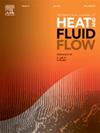Production and survival of early turbulence due to flow modulation at the duct inlet
IF 2.6
3区 工程技术
Q2 ENGINEERING, MECHANICAL
International Journal of Heat and Fluid Flow
Pub Date : 2025-03-13
DOI:10.1016/j.ijheatfluidflow.2025.109792
引用次数: 0
Abstract
The paper reports a fully resolved numerical simulation of turbulent duct flow developing under complex inlet flow conditions at very low Reynolds number based on the channel width and bulk velocity. Turbulence was initiated by inflectional instabilities created at the duct center owing to the special inlet design. All simulations were performed using the open-source software OpenFOAM. Computations reveal that turbulence persisted over more than 60 turnover time. Its statistical features were characterized by distributions of the mean flow and turbulent stresses at multiple duct locations. The turbulent stresses were used to analyze the anisotropic nature of turbulence by evaluating trajectories of across the anisotropy-invariant map which bounds all realizable states of turbulence. The limiting behavior of turbulence stresses reveals explosive production of the dissipation at the wall. This evidence suggests that the chief mechanisms involved during the transition process and self-maintenance of turbulence at very low Reynolds numbers is related to the dynamics of the turbulent dissipation rate which attains the maximum amplification by approaching the two-component isotropic state at the wall.
求助全文
约1分钟内获得全文
求助全文
来源期刊

International Journal of Heat and Fluid Flow
工程技术-工程:机械
CiteScore
5.00
自引率
7.70%
发文量
131
审稿时长
33 days
期刊介绍:
The International Journal of Heat and Fluid Flow welcomes high-quality original contributions on experimental, computational, and physical aspects of convective heat transfer and fluid dynamics relevant to engineering or the environment, including multiphase and microscale flows.
Papers reporting the application of these disciplines to design and development, with emphasis on new technological fields, are also welcomed. Some of these new fields include microscale electronic and mechanical systems; medical and biological systems; and thermal and flow control in both the internal and external environment.
 求助内容:
求助内容: 应助结果提醒方式:
应助结果提醒方式:


